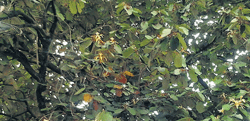Rashmi Shrinivas describes how you can be eco-friendly by using leaves of different trees as plates for your dinner

A number of trees are associated with the serving of food. While fresh leaves of plantain tree are traditionally used to serve food from age old days, leaves of flame-of-the-forest (Muttuga), are also used in the form of patravali made by pinning the leaves together to get a broad plate like structure and storing it, to serve food as the need arises, in some areas.
It is also a known fact that the spades of arecanut trees are also used of late to make preservable plates that can be used to serve food in mass feast and distribution of prasadams in temples including Dharmasthala and Iskcon.
It is not unknown that leaves of Banyan tree are used in distributing prasadam of Vatasavithri vrata (Vata is the Sanskrit name for Banyan tree) and that preserved/fresh leaves of Bauhinia are used for Prasad distribution in many temples in Bangalore. The other day, I was dumbstruck when the the person ironing his customer’s clothes in our street simply plucked a large leaf out of my luxuriantly grown money plant clung to my compound wall and started having food on it! Large-leaves can be used to make a patravali and the usage of plastic can be reduced. This is a normal way of thinking.
The tree commonly refered to as the dinner plate tree is also known as Kanakachampa, Muchakund, Karniker and Bayur is botanically known as Pterospema acerifolia, meaning ‘winged seeded’ and ‘maple leafed’ in Greek. It belongs to the family sterculiaceae, a neighbour of malvaceae (much known hibiscus family). Though a native of the valley of Himalayas and eastern India and Burma, it is also seen near any source of water. With the efforts of Horticultural Department, it is also planted as an ornamental and shade tree on the road side in other areas too. Normal height of this tree is around 50-60 feet.
It branches profusely. But we can notice that its growth is restricted to 30-40 ft on the road side. The leaves are oblong, exceptionally large and about 1 to 1 1/2ft in length and about 1 foot in width. Upper surface of the thick leaves is green while the lower surface is rusty green. Leaf blade is slightly dentate with 2-3 pointed lobes on each side.
Conspicuous white flower of the length of 5-6 inches, is tube like with a thick yellowish calyx with five sepals, completely curled out like an uniformly peeled small banana, when in bloom. The corolla with orange stamens and hidden ovary, are protected by calyx, like in any other flower. Since it grows slowly, its number is too less compared other trees. As the name suggests, leaves can be used to serve food. There are other uses too of this tree. The bark, brown in colour, has orange wood inside, which is used in making planks and wooden boxes due to its light weight and durable nature. The flowers are antioxidant and used in treating ulcers in folk medicine. Research is still going on regarding its medicinal properties. Fragrance of the flower can be used as mosquito repellent and room freshener. Its leaves can also be used as crude thatch.
If the tree resources are properly tapped, by training the rural folk in making boxes and other small decorative items like paper weight, pen stand, key holder, candle stand, wall hanging, key chain, small toys etc, and providing suitable monetary assistance from Banks in the form of repayable loan, it can be a source of income for the needy, thus helping in eradication of poverty to some extent in rural areas. By encouraging the patravali making and their usage, we can also reduce usage of hazardous plastic in our day to day life, thus reducing the pollution of the environment to some extent. Only thing needed is ‘Determination.’